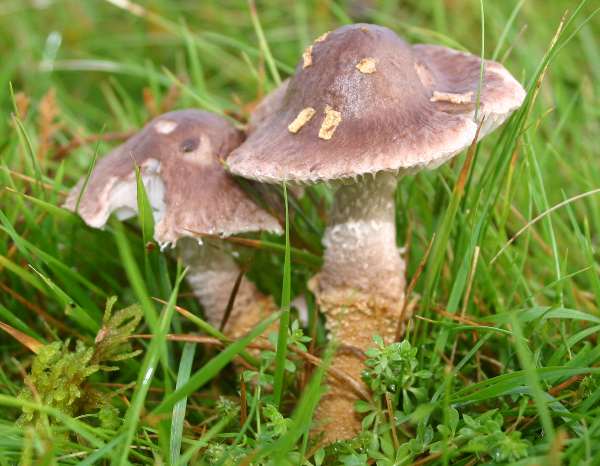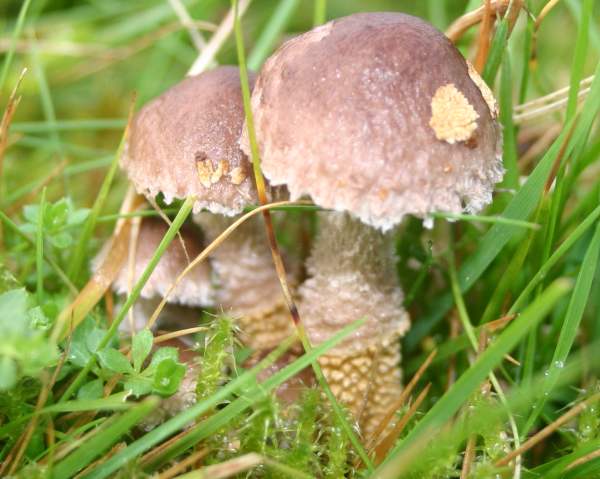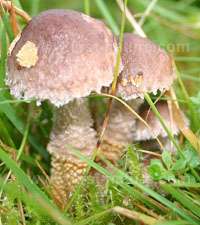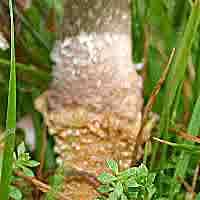Trees Birds Mammals Fish Amphibians Reptiles
Wild Algarve
Bookshop
Squamanita paradoxa (A.H. Sm. & Singer) Bas - Powdercap Strangler
Phylum: Basidiomycota - Class: Agaricomycetes - Order: Agaricales - Family: Tricholomataceae
Distribution - Taxonomic History - Etymology - Identification - Culinary Notes - Reference Sources

This strange fungus is a mycoparasite, attacking another grassland mushroom the Earthy Powdercap. The Powdercap Strangler takes over its host so that a cap and upper stem of Squamanita paradoxa grow out of the lower stem of what would have been a Cystoderma amianthinum mushroom. In the picture, the texture and distinctive orange colouring of the lower stem of Earthy Powdercap is clearly visible, with a stocking-like ring above which the Powdercap Stranger appears.
The rare Squamanita paradoxa mushrooms shown here were photographed in unimproved mossy grassland near Aviemore, in central Scotland.

Distribution
This beautiful parasitic (or should that be cannibalistic?) mushroom is a very rare sight in Britain and Ireland, and its conservation status is recorded as Near Threatened in the Red Data List produced by Shelley Evans et al in 2006. The Powdercap Strangler has also been found in parts of mainland northern Europe as well as in Canada and the USA, but it is extremely rare in all of these places.
Taxonomic history
In 1948 famous American mycologist Alexander H. Smith and German-born mycologist Rolf Singer described this remarkable mushroom based on fruitbodies collected in Mount Hood National Forest, Oregon USA. Smith and Singer gave the Powdercap Strangler the binomial scientific name Cystoderma paradoxum. In 1965 Dutch mycologist Cornelis Bas (1928 - 2013) transferred this species to the genus Squamanita, establishing its currently-accepted scientific name as Squamanita paradoxa.
Etymology
Squamanita, the genus name, suggests that mushrooms in this genus will be scaly (bearing squamules), while the specific epithet paradoxa reflects the puzzling nature of this species, which when it was first found was thought to be a new powdercap (Cystoderma) species.
Identification guide

|
Cap
2 to 3cm across; initially convex, becoming broadly convex or flat; colour brownish-violet but paler towards the rim; covered in shaggy scales.
Gills
White at first, becoming cream. |

|
Stem
4 to 7cm long and 4 to 8mm diameter. The lower part is orange and coarsely scaly, topped by a collar-like persistent ring; the upper part is pale brownish-lilac and finely scaly. |
| |
Spores
Ellipsoidal, smooth, 8-11 x 4.5-6µm; inamyloid or wreakly dextrinoid.
Spore print
White. |
Odour/taste |
Odour slightly perfumed becoming foetid in old fruitbodies; taste mild but not distinctive. |
Habitat & Ecological role |
Parasitic on Cystoderma amianthinum, the Earthy Powdercap . |
Season |
Summer and autumn. |
Related species |
See Cystoderma amianthinum, the Earthy Powdercap, which this fungus parasitises. |
Culinary Notes
Squamanita paradoxa is an extremely rare mushroom and it should not be collected.
Reference Sources
Bas C 1965. The genus Squamanita. Persoonia 3: 331-359.
Matheny PB, Griffith GW 2010. Mycoparasitism between Squamanita paradoxa and Cystoderma amianthinum (Cystodermateae, Agaricales). Mycoscience 51: 456-461.
Fascinated by Fungi, 2nd Edition, Pat O'Reilly 2016, reprinted by Coch-y-bonddu Books in 2022.
Dictionary of the Fungi; Paul M. Kirk, Paul F. Cannon, David W. Minter and J. A. Stalpers; CABI, 2008
Taxonomic history and synonym information on these pages is drawn from many sources but in particular from the British Mycological Society's GB Checklist of Fungi.
Top of page...
Fascinated by Fungi. Back by popular demand, Pat O'Reilly's best-selling 450-page hardback book is available now. The latest second edition was republished with a sparkling new cover design in September 2022 by Coch-y-Bonddu Books. Full details and copies are available from the publisher's online bookshop...